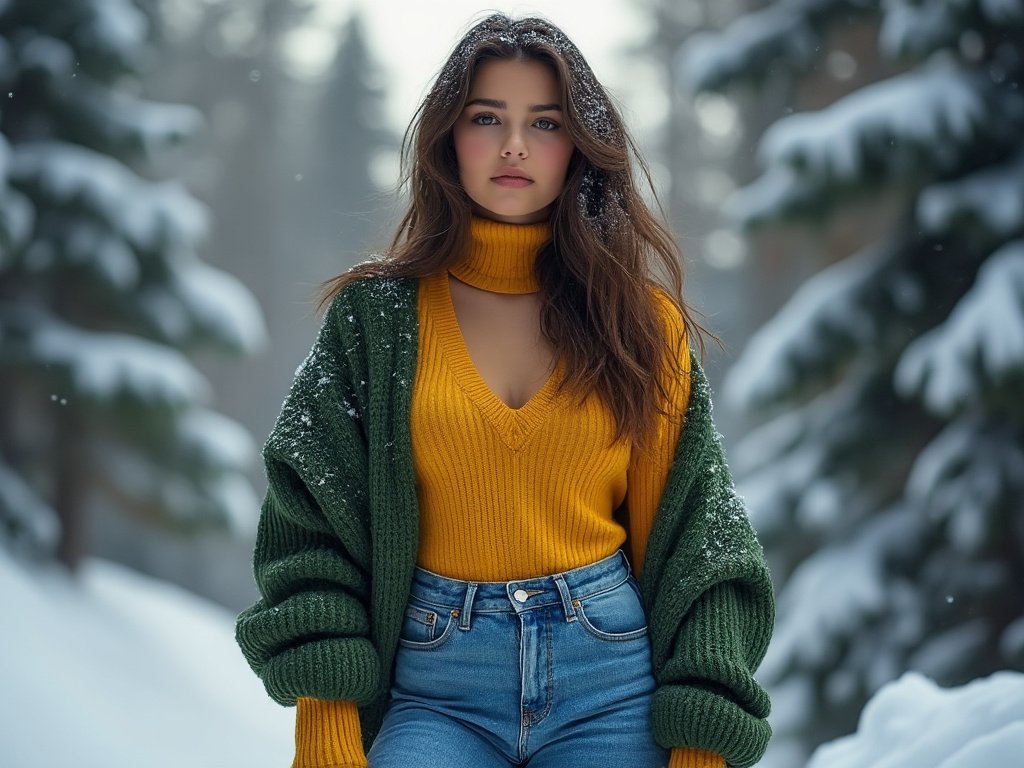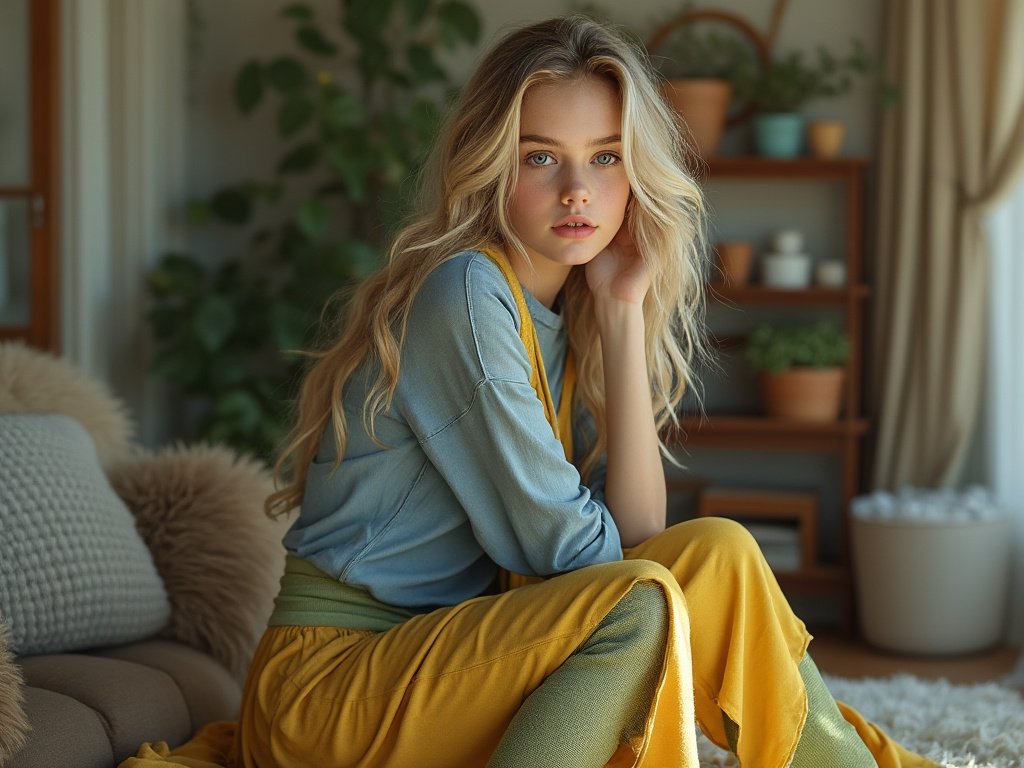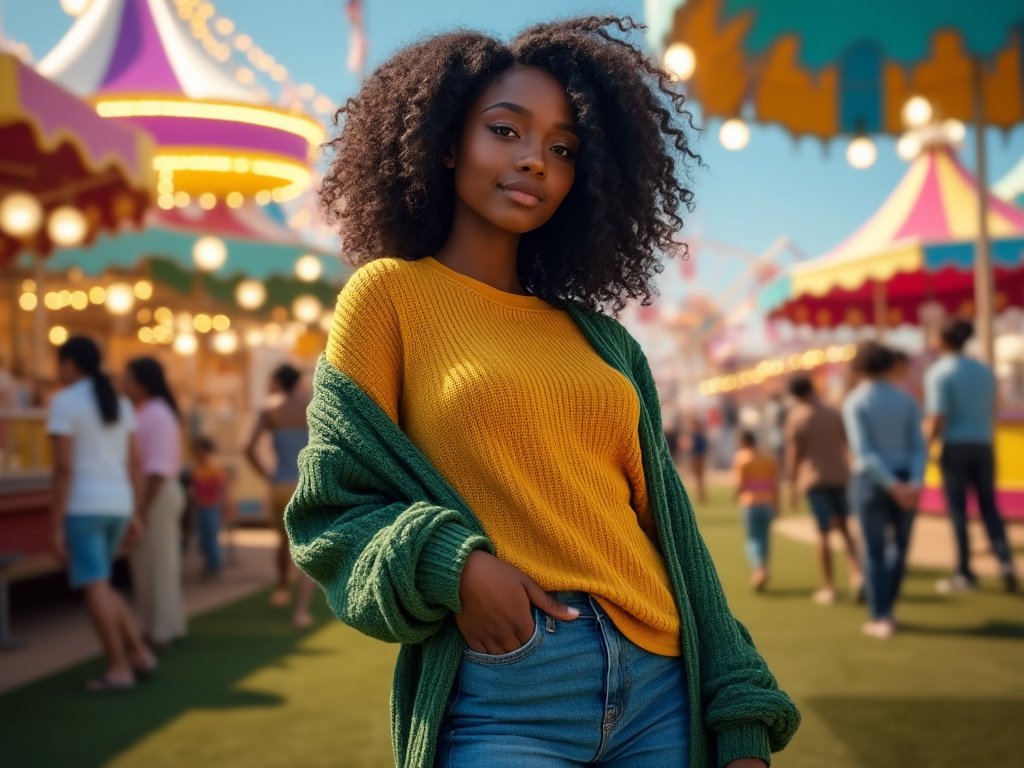Key Takeaways
- Color harmony principles are essential for creating balanced outfits
- Blue, yellow, and green form a versatile and nature-inspired color palette
- Understanding color psychology enhances outfit choices for different occasions
- Seasonal color analysis helps determine the most flattering shades for your complexion
- Mixing textures and patterns within this palette adds depth to your look
- Accessories play a crucial role in tying together blue, yellow, and green ensembles
- Transitioning this palette across seasons keeps your wardrobe fresh year-round
- Sustainable fashion choices align well with this nature-inspired color scheme
Nature has always been a boundless source of inspiration for fashion enthusiasts and designers alike. The harmonious blend of blue, yellow, and green – colors that dominate our natural world – creates a fresh and vibrant palette that can breathe new life into any wardrobe.
From the azure skies and golden sun to lush forests and meadows, these hues offer a spectrum of possibilities for crafting eye-catching and balanced outfits. Whether you’re looking to make a bold statement or create a subtle, sophisticated look, mastering the art of combining these colors can elevate your style to new heights. Let’s dive into the world of blue, yellow, and green, exploring how to harness nature’s palette for a truly fresh and invigorating look.

The Power of Color Harmony
Color harmony is the secret ingredient that turns a simple outfit into a head-turning ensemble. When it comes to blue, yellow, and green, we’re dealing with a triad of hues that naturally complement each other, creating a visual balance that’s both pleasing to the eye and energizing to the spirit.
Understanding the Color Wheel
The color wheel is more than just a pretty circle of hues – it’s a powerful tool for creating harmonious color combinations. Blue, yellow, and green form a split-complementary color scheme, with blue opposite the warm tones of yellow and green. This relationship creates a dynamic tension that can make your outfits pop without clashing.
Think of it as nature’s own balancing act. The cool serenity of a blue sky provides the perfect backdrop for the warm glow of sunflowers or the vibrant green of new leaves. By understanding this fundamental principle, you can recreate that same sense of balance and harmony in your wardrobe.
The Psychology Behind Blue, Yellow, and Green
Colors have the power to influence our moods and perceptions, and blue, yellow, and green are no exception. Blue evokes feelings of trust, stability, and calm – perfect for professional settings or when you want to appear approachable. Yellow radiates optimism, energy, and creativity, making it ideal for social gatherings or when you need a confidence boost. Green, associated with growth and harmony, can help you feel grounded and refreshed.
By tapping into the psychological effects of these colors, you can strategically choose outfits that not only look great but also help you project the right mood for any occasion. Imagine walking into an important meeting wearing a crisp blue blazer – you’re already communicating competence and reliability before you’ve said a word.
Balancing Cool and Warm Tones
The key to mastering this palette lies in finding the right balance between cool and warm tones. Blue, being a cool color, can be beautifully offset by the warmth of yellow or the freshness of green. This interplay creates depth and interest in your outfit, preventing it from feeling flat or monochromatic.
Consider pairing a navy blue dress with lemon yellow accessories, or a forest green sweater with sky blue jeans. The contrast between cool and warm creates a visual feast that draws the eye and keeps your look engaging. It’s like watching a sunset over the ocean – the interplay of colors is what makes it truly breathtaking.
Embracing Nature’s Palette in Your Wardrobe
Incorporating blue, yellow, and green into your wardrobe is like bringing a slice of the outdoors into your everyday life. These colors offer a refreshing change from the often-seen neutrals and can breathe new life into your style.
Selecting Your Shade Spectrum
The beauty of this color trio lies in its versatility. From deep navy to pale sky blue, from mustard to pastel yellow, and from olive to mint green, there’s a vast spectrum to explore. The key is finding the shades that resonate with your personal style and complement your skin tone.
Start by identifying your undertones – are you warm, cool, or neutral? This will help guide you towards the most flattering shades within the blue-yellow-green palette. For instance, if you have warm undertones, you might gravitate towards golden yellows and olive greens, while cool undertones often shine in icy blues and emerald greens.
Mixing and Matching for Maximum Impact
Once you’ve identified your ideal shades, it’s time to start mixing and matching. The possibilities are endless, but here are a few tried-and-true combinations to get you started:
- Navy blue trousers with a soft yellow blouse and emerald green accessories
- A forest green dress paired with mustard yellow shoes and a pale blue scarf
- Mint green shorts with a royal blue top and lemon yellow jewelry
Remember, the goal is to create a balanced look that feels harmonious, not chaotic. Start with one dominant color and use the others as accents. This approach allows you to experiment without overwhelming your outfit.
Texture and Pattern Play
Don’t be afraid to play with textures and patterns within this color scheme. A chunky blue knit sweater can look stunning with sleek yellow trousers. Or try a floral print that incorporates all three colors for a cohesive yet dynamic look.
Patterns like stripes, polka dots, or even abstract designs can add an extra layer of interest to your blue, yellow, and green ensemble. Just remember to keep the scale of patterns in mind – mix larger prints with smaller ones to maintain balance.
The Art of Accessorizing
Accessories are the secret weapons of any well-dressed individual, and they play a crucial role in perfecting your blue, yellow, and green looks. The right accessories can tie an outfit together, add pops of color, or provide subtle accents that elevate your entire ensemble.
Statement Pieces in Complementary Colors
When working with blue, yellow, and green, consider using accessories as your bold color statements. A vibrant yellow handbag can be the perfect finishing touch to a predominantly blue outfit. Or, try a pair of emerald green earrings to add a touch of elegance to a yellow sundress.
Don’t shy away from mixing metals either. Gold jewelry can warm up cool blue tones, while silver can add a crisp, modern edge to yellows and greens. The key is to choose pieces that complement your outfit without competing for attention.
Neutral Accents for Balance
While embracing the vibrancy of blue, yellow, and green, remember that neutral accessories can provide a much-needed visual break. A cream-colored belt, for instance, can beautifully break up a blue top and green bottom. Or, consider brown leather shoes to ground a colorful outfit and add a touch of earthy sophistication.
Layering for Depth
Layering accessories is an art form in itself. Start with delicate pieces and build up to bolder items. A thin gold necklace layered with a chunky blue pendant can create an interesting focal point. Or, stack bracelets in varying shades of green for a bohemian touch.

Dressing for Different Occasions
One of the greatest strengths of the blue, yellow, and green palette is its versatility. These colors can be adapted to suit a wide range of occasions, from casual outings to formal events.
Casual Chic
For everyday wear, embrace the relaxed vibes of this nature-inspired palette. Think comfortable yet stylish:
- Distressed blue jeans paired with a soft yellow t-shirt and green sneakers
- A flowy green maxi dress with blue denim jacket and yellow sandals
- Yellow chino shorts, a blue and white striped top, and green canvas slip-ons
The key to casual chic is effortlessness. Mix and match these colors in soft, breathable fabrics for a look that’s both comfortable and put-together.
Office Appropriate
Bringing blue, yellow, and green into your work wardrobe can add a refreshing twist to traditional office attire:
- A tailored navy blue suit with a pale yellow blouse and green statement necklace
- A forest green pencil skirt paired with a light blue button-down and yellow heels
- Khaki trousers, a mustard yellow blazer, and a crisp white shirt with blue accents
Remember to keep the overall look polished and professional. Opt for more subdued shades and incorporate neutrals to maintain a business-appropriate aesthetic.
Evening Elegance
For those special nights out, blue, yellow, and green can create truly stunning evening looks:
- A floor-length royal blue gown with gold accessories and emerald green earrings
- A sleek yellow cocktail dress paired with blue velvet pumps and a green clutch
- An emerald green jumpsuit accented with navy and gold jewelry
The key to evening elegance is in the details. Choose rich fabrics, add a touch of shimmer, and don’t be afraid to go bold with your color choices.
Seasonal Transitions
One of the most exciting aspects of working with blue, yellow, and green is how seamlessly these colors transition through the seasons. With a few clever adjustments, you can keep your wardrobe fresh and appropriate all year round.
Spring Awakening
As nature bursts into life, let your wardrobe follow suit:
- Light and airy fabrics in pastel blues and greens
- Soft yellow sundresses paired with denim jackets
- Floral prints incorporating all three colors
Spring is the perfect time to embrace lighter shades and playful patterns. Think blooming meadows and clear spring skies as your inspiration.
Summer Brights
When the temperatures rise, so can the vibrancy of your colors:
- Bold yellow shorts with a breezy blue top
- Vibrant green maxi dresses with golden accessories
- Color-blocked swimwear in all three hues
Summer is the season to go all out with your blue, yellow, and green palette. Don’t be afraid to mix bright, saturated colors for a truly eye-catching look.
Autumn Richness
As the leaves change, transition to deeper, richer tones:
- Mustard yellow sweaters paired with dark wash jeans
- Olive green trousers with a navy blue blazer
- Jewel-toned accessories in emerald and sapphire
Autumn is the perfect time to explore the more muted side of this color palette, incorporating earthy tones and cozy textures.
Winter Warmth
Even in the coldest months, blue, yellow, and green can keep your wardrobe lively:
- Deep blue wool coats with mustard yellow scarves
- Forest green velvet dresses for holiday parties
- Chunky knit sweaters in a mix of all three colors
Winter is all about layering, so use this opportunity to play with different shades and textures within your blue, yellow, and green theme.

Sustainable Style Choices
In today’s fashion landscape, sustainability is more than just a trend – it’s a necessity. The good news is that embracing a nature-inspired palette like blue, yellow, and green aligns perfectly with eco-friendly fashion choices.
- Choose natural, biodegradable fabrics like organic cotton, linen, and hemp
- Look for clothing made from recycled materials, especially in blue tones (often derived from recycled denim)
- Opt for quality pieces in classic styles that will stand the test of time
- Support brands that use eco-friendly dyes, particularly for vibrant yellows and greens
- Consider second-hand and vintage shopping to give pre-loved blue, yellow, and green pieces a new life
- Invest in versatile items that can be mixed and matched to create multiple outfits
- Care for your clothes properly to extend their lifespan
- When possible, choose locally made items to reduce carbon footprint
- Look for certifications like GOTS (Global Organic Textile Standard) or Fair Trade
- Consider renting special occasion wear in these colors instead of buying
Remember, the most sustainable clothing is the kind you’ll wear again and again. By choosing a versatile palette like blue, yellow, and green, you’re setting yourself up for a wardrobe that remains fresh and exciting season after season.
Color Coordination Tips for Beginners
If you’re new to playing with color in your wardrobe, the prospect of combining blue, yellow, and green might seem daunting. But fear not! With a few simple tips, you’ll be mixing these hues like a pro in no time.
Start Small
If you’re hesitant about diving headfirst into colorful outfits, start by incorporating small pops of color:
- Add a yellow belt to a blue dress
- Wear green earrings with a neutral outfit
- Try a patterned scarf that includes all three colors
These small additions can help you get comfortable with the palette without feeling overwhelmed.
The 60-30-10 Rule
This classic interior design rule translates beautifully to fashion. Choose one dominant color (60%), a secondary color (30%), and an accent color (10%). For example:
- A blue dress (60%) with a green cardigan (30%) and yellow shoes (10%)
- Green pants (60%) with a blue top (30%) and yellow jewelry (10%)
This approach ensures a balanced look that’s eye-catching without being chaotic.
Monochromatic Magic
If you’re unsure about mixing different colors, try a monochromatic look using different shades of the same color:
- Pair navy blue trousers with a sky blue top and royal blue accessories
- Layer various shades of green, from sage to emerald
- Experiment with yellows, from pale lemon to rich gold
Monochromatic outfits are sophisticated and easy to put together, making them perfect for color coordination beginners.

The Role of Skin Tone and Hair Color
Understanding how blue, yellow, and green interact with your natural coloring can help you choose the most flattering shades for your complexion.
Cool Undertones
If you have cool undertones (pink, red, or blue), you might find that certain shades complement you best:
- Bright, clear blues like royal or electric blue
- Icy pastels, including mint green and lemon yellow
- Jewel tones like sapphire, emerald, and canary yellow
These colors tend to enhance the natural coolness in your skin, creating a harmonious look.
Warm Undertones
For those with warm undertones (golden, peachy, or yellow), consider these options:
- Navy blue or teal
- Olive or forest green
- Golden yellow or mustard
These warmer variations of blue, yellow, and green will complement the natural warmth in your skin tone.
Neutral Undertones
If you have neutral undertones, congratulations! You have the flexibility to wear a wide range of blues, yellows, and greens. Experiment with different shades to find your favorites.
Embracing Bold Color Combinations
Once you’ve mastered the basics of combining blue, yellow, and green, it’s time to push the boundaries and create truly unique looks.
Color Blocking
Color blocking is a fun and impactful way to wear bold colors:
- Pair a bright yellow top with cobalt blue trousers
- Try a color-blocked dress that incorporates all three hues
- Layer a green blazer over a blue dress and add yellow accessories
The key to successful color blocking is confidence – wear your bold choices with pride!
Unexpected Pairings
Don’t be afraid to try combinations that might seem unconventional at first:
- Mix patterns, like a striped blue and white top with floral green pants
- Combine different shades, such as pastel yellow with deep forest green
- Play with proportions, like an oversized blue sweater with fitted yellow pants
These unexpected pairings can lead to truly memorable outfits that showcase your personal style.
Ombre and Gradient Effects
Explore clothes that blend blue, yellow, and green in gradient or ombre effects:
- A dress that fades from blue at the top to green at the bottom
- An ombre scarf that transitions through all three colors
- Gradient dyed fabric that creates a watercolor effect
These pieces can serve as statement items that tie your whole look together.

Caring for Your Colorful Wardrobe
To keep your blue, yellow, and green pieces looking vibrant and fresh, proper care is essential.
Washing Tips
- Sort your laundry carefully to prevent color bleeding
- Use cold water for most colored items to preserve the dye
- Consider hand-washing delicate or particularly vibrant pieces
- Turn garments inside out before washing to protect the outer surface
Storage Solutions
- Store colored items away from direct sunlight to prevent fading
- Use padded hangers for delicate items to maintain their shape
- Consider using garment bags for special pieces to protect them from dust and light
Reviving Faded Colors
- Try color-safe bleach alternatives to brighten yellows
- Use vinegar rinses to refresh greens and blues
- Consider professional color restoration for special items
Summary Table
| Color | Psychological Effect | Best Occasions | Complementary Colors |
|---|---|---|---|
| Blue | Calm, Trust, Stability | Professional, Formal | Yellow, Orange |
| Yellow | Energy, Optimism, Creativity | Casual, Social | Purple, Blue |
| Green | Growth, Harmony, Nature | Outdoor, Relaxed | Red, Magenta |
Conclusion
Embracing the vibrant palette of blue, yellow, and green opens up a world of possibilities for your wardrobe. These nature-inspired hues offer a perfect balance of cool and warm tones, allowing you to create looks that are both visually striking and emotionally resonant.
By understanding the principles of color harmony, leveraging the psychological effects of these colors, and experimenting with different shades, textures, and patterns, you can transform your style in a way that feels both fresh and authentic. Whether you’re dressing for casual outings, professional settings, or special occasions, blue, yellow, and green provide a versatile foundation that can be adapted to suit any situation.

Frequently Asked Questions
How do I know which shades of blue, yellow, and green suit me best?
Understanding your skin tone is crucial. Warm undertones pair well with golden yellows, olive greens, and teal blues. Cool undertones are complemented by icy blues, mint greens, and lemon yellows. Neutral undertones can experiment with a wider range of shades.
Can I wear blue, yellow, and green year-round?
Absolutely! Each season brings its own take on these colors. Spring and summer are perfect for lighter, brighter shades, while autumn and winter call for deeper, richer tones. Adjust your wardrobe to include season-appropriate fabrics and accessories.
How can I incorporate these colors without overwhelming my outfit?
Start with small pops of color using accessories like scarves, belts, and jewelry. Gradually incorporate larger pieces, such as tops or skirts, into your wardrobe. The 60-30-10 rule can help you balance these colors effectively.
Are there any fashion rules I should follow when combining these colors?
While fashion is ultimately about personal expression, some general guidelines can help. Use the color wheel to find harmonious combinations, balance cool and warm tones, and mix textures and patterns thoughtfully to add depth without chaos.

How can I transition these colors from day to night?
For day looks, keep things light and casual with airy fabrics and simple silhouettes. Transition to evening by opting for richer fabrics like velvet or silk, and adding bold accessories. For example, a simple yellow sundress can be dressed up with a navy blazer and emerald earrings.
What role do accessories play in these color combinations?
Accessories are key in tying your outfit together. They can add pops of color, create focal points, and balance the overall look. Consider statement pieces in complementary colors or neutral accents to provide visual breaks.
How do I care for my blue, yellow, and green clothing?
Proper care ensures your clothes stay vibrant and fresh. Sort laundry by color, use cold water, and avoid direct sunlight when storing. Hand-wash delicate items and use padded hangers to maintain shape. Color-safe bleach alternatives and vinegar rinses can help revive faded items.
Can these colors be sustainable choices in fashion?
Yes! Opt for natural, biodegradable fabrics like organic cotton, linen, and hemp. Support brands using eco-friendly dyes, and consider second-hand shopping. Investing in quality pieces and caring for them properly extends their lifespan, aligning with sustainable fashion practices.
By embracing the vibrant palette of blue, yellow, and green, you can infuse your wardrobe with a fresh, nature-inspired energy. These colors not only enhance your style but also reflect a harmonious connection with the natural world, making every outfit a statement of both beauty and balance.

Lenny Terra is a vibrant force in the world of fashion and design. Effortlessly blending his expertise in colors with a keen artistic vision, he unveils the most sought-after hues of the season, turning ordinary ensembles into iconic looks. His knack for creating visually enthralling content ensures that every piece resonates with readers, offering them a mesmerizing journey through the realms of color and fashion. Lenny’s unmatched skills not only elevate the aesthetics but also promise an enchanting experience every time. Dive into his creations and let the colors speak for themselves.
Reviewed By: Joanna Perez and Anna West
Edited By: Marcella Raskin
Fact Checked By: Sam Goldman
Photos Taken or Curated By: Matthew Mansour
